Are you getting ready to teach the letter f sound?
Do you want to make sure your practice is aligned with the “Science of Reading” (SoR)?
First, let’s talk about the order of letter sound introduction. What’s the best sequence? Some teachers like to go in a-z order. Others prefer to prioritize the most common letters like s and a, saving the least common letters like j and v for last. This option makes the most sense to me, so that students can begin reading and writing common, meaningful words as soon as possible. But you may have a different sequence that you like and good reasons for choosing it.
While I don’t have a super strong opinion about letter sound sequence, I do have a passionate preference for HOW to introduce a new letter and its related sound.
Whereas I used to say something like this to teach the letter and sound for f:
“Let’s meet the letter f (holding up a card with the printed letter f). F says /f/, as in fan (showing a picture of a fan). Repeat after me, F, fan, /f/”.
For the past few years I’ve been implementing a slightly different routine, and the results have been impressive.
Below I’ll share what I do and why I do it. I hope that in this article, you’ll find something new and easy to try with your own students. I’m cheering for your success!
Routine for Introducing the Letter F and Its Sound
You can watch this video to get an idea of the entire routine. You can also play it for your students!
Start with speech.
Why?
Our brains are naturally wired for speaking, not reading. Starting with speech, as opposed to print, gives our students an instant win. All they have to do is listen to their teacher and repeat each word they hear. There’s no pressure, and it’s comfortable and familiar. There’s nothing abstract like letter names or printed letters yet.
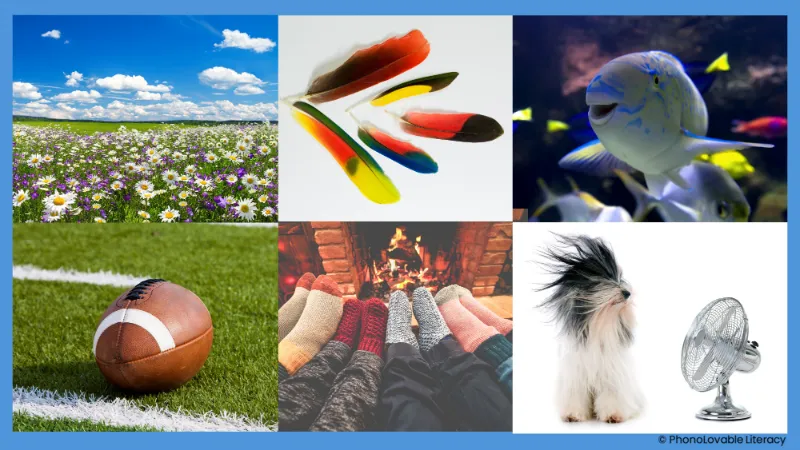

How?
Say 3-6 words that begin with the letter f, such as feathers, footballs, and fish. Ask children to repeat each word after you say it, while showing a photo of each word if you can. This adds interest and can be especially helpful for students with limited English vocabulary or short attention spans. If you don’t have pictures on hand, that’s fine too. Tell students that all of these words begin with the sound /f/.
Draw attention to what your mouth does when you make the /f/ sound.
Why?
Drawing our children’s attention to how our mouths look and feel while producing the /f/ sound makes an abstract concept (such as a letter) more concrete. It simply adds another layer of connection to serve as a bridge between the phoneme and the grapheme. Students can both see and feel the sound being produced.
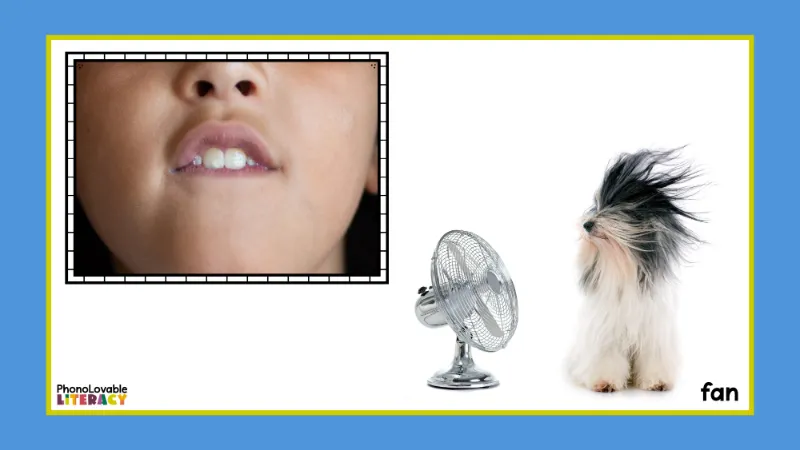

How?
Ask students to notice what their mouth is doing to make the sound /f/. If you are in small group, hold up a mirror to let students see for themselves. Draw attention to the fact that our top teeth press down on our bottom lip and we blow out air. I put my hand in front of my mouth to feel the release of air and ask students to do the same. Display a sound articulation card (mouth pic) for students to see the teeth and lips of a student making the /f/ sound.
Introduce the printed letter with an EMBEDDED mnemonic.
Why?
The research on this is clear. Studies going back decades found that using embedded keyword images to teach phoneme-grapheme relationships was more effective for student acquisition AND retention of taught letter sounds than other methods. The other methods include what you’ll find in many phonics programs today – a keyword pictured above, below, or beside the printed letter.
One study even found that using no picture (just a keyword) was more effective than having a picture next to (not embedded within) the letter!
Having an embedded picture in the letter was the most beneficial method. While not ALL students NEED to have an embedded mnemonic to learn letter sounds, it’s an easy way to prevent or minimize reading failure, especially for many of our at-risk students.
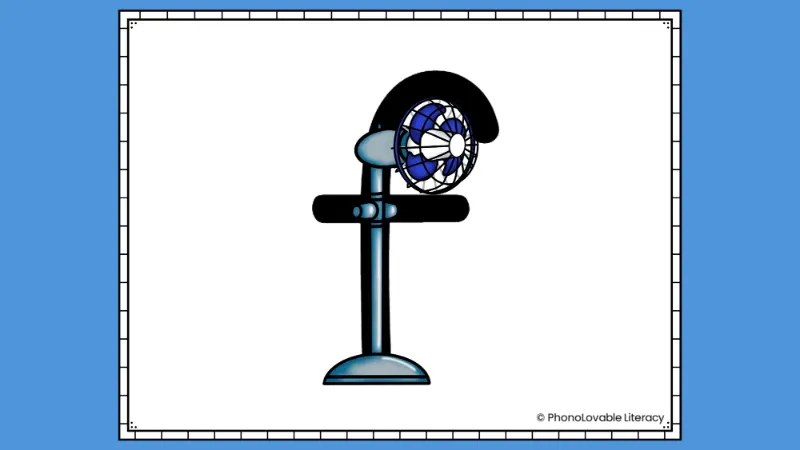

How?
Here is where you’ll first show your students the actual letter. But not just a plain letter, an embedded letter. The image of a keyword such as a fan embedded in the letter f helps solidify the connection between letter and sound. The shape of the fan, corresponding to the shape of the lowercase letter f, will serve as a reminder of the phoneme-grapheme correspondence. The embedded image can be faded over time as students gain mastery of the letter-sound relationship.
Model and practice how to write the letter.
Why?
Reading and writing are interconnected. We teach letter sounds so that students may not only read new words but learn to write them as well. As an interventionist who works with students from kindergarten to 4th grade, I’ve seen how hard it is to undo inefficient letter formation habits.
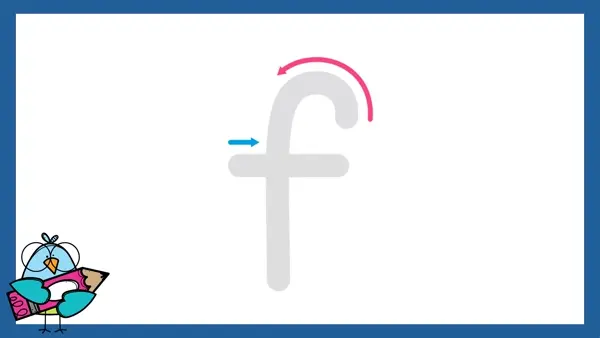

How?
I try to make my letter formation phrasing and tone singsongy to aid in memory. You may have different wording from a program you’ve used, or you may wish to change up how you say this, but here’s what I say as I model how to write the lowercase letter f.
“Curve up to touch the top. Then pull down to the bottom. Pick it up and cross at the middle.” I model with my hand in the air and/or show an animated slide on my computer (in small group) or smart TV (in whole group). Ask students to follow along with their fingers in the air. If children are seated at desks, ask them to finger-write the letter f on the desk.
After a few finger-writing attempts, I have my students practice with pencils on paper or dry-erase markers on whiteboards. Since f can be a tricky one to write, I keep a close watch as they write, giving guidance, encouragement, and corrective feedback as needed.
Research-Aligned Alphabet Resources
Do you need engaging resources that are aligned to the research-based steps above?
Here are my recommendations for introducing the letter f and the rest of the alphabet to your preschool or kindergarten children:
Initial Sound Slides: These no-prep slides introduce each letter sound in the most effective and efficient way. With each click, you will show images of interesting photographs containing the beginning sound, a photo of a real kid making the sound along with a keyword image, the letter with an embedded mnemonic image, and lastly, an animated letter formation slide (one for uppercase and one for lowercase letters).
Mnemonic Alphabet Articulation Mouth Cards | Alphabet Posters with Real Pictures: If you prefer a paper option or don’t have access to digital resources, you may like these printable, 1-page posters of mouth pics along with the embedded mnemonic letters. It’s also a nice way to display the alphabet if you have classroom wall space.
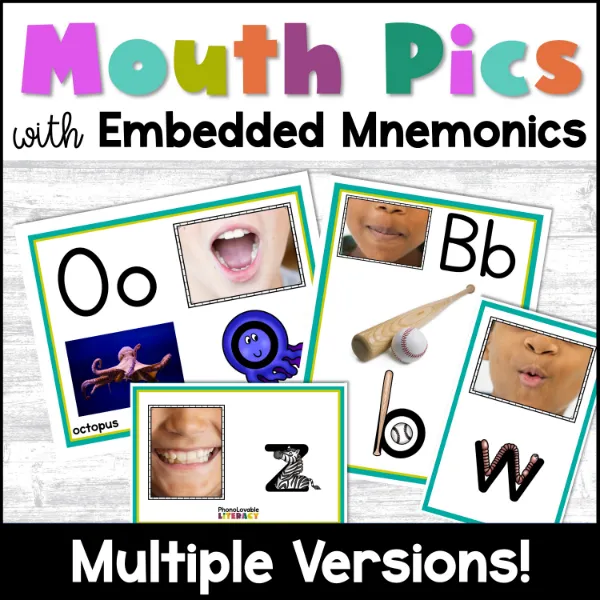

Alphabet Picture Cards with Embedded Mnemonics: This set of printable pages comes with embedded letter cards in two sizes. Teach phonemes for 21 consonants, 5 short vowels, AND consonant digraphs WH, TH, SH, CH, and CK.
Get a free set of small embedded letter cards when you join us in our newsletter community!
Looking for an “everything bundle” of embedded letter resources, including digital slides, letter cards, worksheets, games, and more? Save nearly 50% and receive all 12 resources. Get your students quickly and effectively mastering letter sounds so they can begin the even more exciting discovery of how to read and write words!
Sources:
Ehri, L. C., Deffner, N. D., & Wilce, L. S. (1984). Pictorial mnemonics for phonics. Journal of Educational Psychology, 76(5), 880–893. https://doi.org/10.1037/0022-0663.76.5.880
Ehri, L. C. (2013). Orthographic Mapping in the Acquisition of Sight Word Reading, Spelling Memory, and Vocabulary Learning. Scientific Studies of Reading, 18(1), 5–21. https://doi.org/10.1080/10888438.2013.819356
Ehri, L.C. (2022). What Teachers Need to Know and Do to Teach Letter–Sounds, Phonemic Awareness, Word Reading, and Phonics. The Reading Teacher, 76(1), 53-61. https://doi.org/10.1002/trtr.2095
McNamara, G. (2012). The effectiveness of embedded picture mnemonic alphabet cards on letter recognition and letter sound knowledge. Theses and Dissertations. 302. https://rdw.rowan.edu/etd/302
Shmidman, A., & Ehri, L. (2010). Embedded Picture Mnemonics to Learn Letters. Scientific Studies of Reading, 14(2), 159–182. https://doi.org/10.1080/10888430903117492

